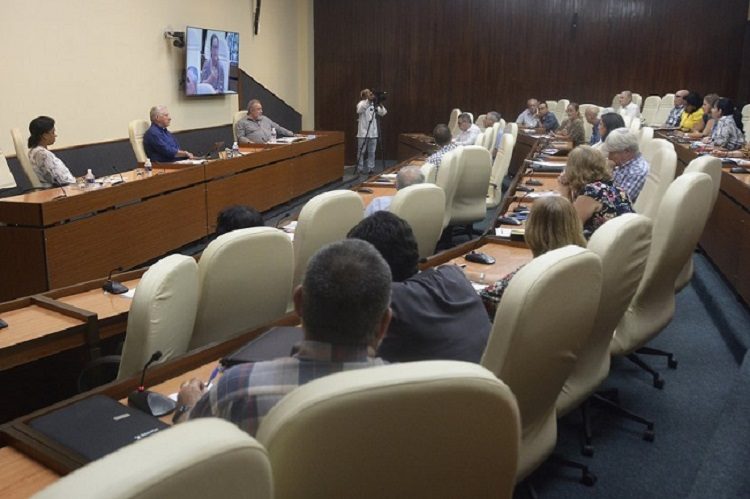Written by: Alina Pereira Rubio
Faced with the lifelong danger of dengue, Cuba—an expert in the disease, and in so many others who forced her to embark on continuous learning paths—is now waging a new epidemiological battle, and must set the priorities that allow it to do so. Succeed over all adversity or shortcoming.
In this direction of thinking, Politburo member and Prime Minister Manuel Marrero spoke this Tuesday, from the Palace of the Revolution, during the meeting of the Temporary Working Group on the Prevention and Control of COVID-19 as well as Dengue, chaired by First Secretary of the Central Committee of the Communist Party and President of the Republic Miguel Diaz-Canel Bermudas.
In a meeting also emerging from the presidency with Politburo member and Vice-President of the Republic, Salvador Valdes Mesa, the Head of Government expressed that given the complexity of a disease such as dengue, and his awareness of difficulties such as the lack of fuel and other resources, it is necessary to make an effort, and not to neglect tasks of the first order such as Garbage collection, fumigation or compliance with established procedures.
“Really – stressed the Prime Minister – today we have a major risk concentrated in dengue fever.” That is why he asked to unite “all forces, resources, and priorities” to counter the dispatch.
At the meeting, regarding the epidemiological situation of dengue fever and Aedes Aegypti in Cuba, the Minister of Public Health, José Angel Portal Miranda, shared the data obtained up to week 35 (closed on September 3), which highlighted that 14 provinces, 41 municipalities and 58 healthy areas transmit the disease.
The headline added that the rate of suspected dengue cases increased compared to the previous week. and that the areas with higher rates than national ones, and therefore higher risks, are – in descending order of numbers – the provinces of Santiago de Cuba, Havana, Guantanamo, Isla de la Juventud Special Municipality, Camagüey, Las Tunas and Matanzas.
Jose Angel Portal Miranda reported that nine provinces saw an increase in the rate of suspected cases, compared to the previous week. They are Santiago de Cuba, Havana, Matanzas, Villa Clara, Camagüey, Mayapeque, Artemisa, Sancti Spiritus and Granma.
Through the video conference, the authorities of each province informed the state leadership of the behavior of the COVID-19 epidemic, the situation of electric power, and other issues related to the national situation. This day was preceded by a meeting of experts and scholars on health issues; chaired by President Diaz-Canel; by Prime Minister Manuel Marrero Cruz; As well as Deputy Prime Minister Ines Maria Chapman Wu.
From the usual mathematical prediction models, d. What is expected is “to maintain control of COVID-19 in all the territory of the country,” said Raul Genovart Diaz, dean of the Faculty of Mathematics and Computing at the University of Havana.
The expert highlighted that the situation on the island is still favorable, at the starting point for the effectiveness of treatment protocols, as well as in the effectiveness of vaccines. But he cautioned that the epidemic has yet to be resolved on the international scene, with the Asian region or countries such as Chile or Italy keeping unfavorable statistics.
At Tuesday’s meetings, the issue of dengue fever was first addressed by Dr. Maria Guadalupe Guzmán Tirado, Director of the Research Center at the Pedro Curi Institute of Tropical Medicine (IPK), who developed the idea in reference to the research results of that scientific institution to counter the disease that Cuba knows well.
Pointing to the certainties that have characterized decades of work, the expert spoke about the scientific contributions that Cuba has made to the world in the fight against dengue fever, a disease caused by four viruses and that in most cases it is asymptomatic.
With regard to this disease, which has been indicated in mankind since 265 BC, the Doctor of Science indicated that it is currently estimated that there are 2.5 billion people at risk of infection. One hundred countries have reported transmission of the disease, he said, and in the Americas region, at the moment, the countries with the highest transmission rates (according to 2022 data) are Brazil, Peru, Colombia, Nicaragua, and Mexico.
Maria Guadalupe Guzmán Tirado noted that the island had a network of laboratories, “a very good and very sensitive system”; and that “surveillance is ongoing for viruses circulating” not only for dengue fever but also for other mosquito-borne diseases.
Through the drawings, the expert made a detailed tour of the dengue epidemics recorded and labeled by Cuba – since 1977, when the first case occurred, until 2022 -. He commented that the situation became more complicated, because in the past it was caused by one virus and it was easier to move forward, but later “there have been outbreaks and epidemics of two viruses, and so far the four serotypes are spreading.”
Speaking about the contributions from the Caribbean nation to the world’s scientific community, the Doctor of Science mentioned that made by Al Jazeera, which is still valid, which addresses the overarching hypothesis about dengue hemorrhagic fever, and why or not a person gets it. .
He stressed that “Cuba contributed a lot to the dengue clinic,” and played “a fundamental role in the new classification issued by the World Health Organization for dengue fever, with or without warning signs, which will aim at not worsening the patient’s condition.”
(taken from President.gob.cu)

“Unapologetic tv specialist. Hardcore zombie trailblazer. Infuriatingly humble problem solver.”

:quality(85)/cloudfront-us-east-1.images.arcpublishing.com/infobae/PAGKJH7CJBDBHOF4XHKELQPZV4.jpg)





More Stories
Increased retirement age in the Czech Republic
Breaking news on Gaza and pro-Palestinian protests on American campuses, live: news and more
Labor Day in Haiti with repeated demands from workers